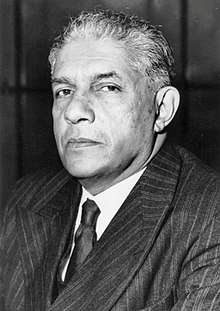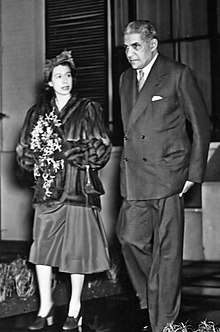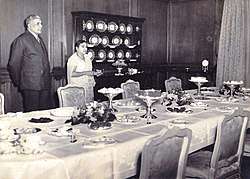Edwin Wijeyeratne
Sir Edwin Aloysius Perera Wijeyeratne KBE (Sinhala: ශ්රිමත් එඩ්වින් ඇලෝසියස් පෙරේරා විජයරත්න) (8 January 1889 – 19 October 1968), known as Edwin Wijeyeratne, was a Sri Lankan lawyer, politician, diplomat,[6][7] and one of the founding members of United National Party. He was a Senator and Minister of Home Affairs and Rural Development in the government of D.S.Senanayake.[8][9]
Sir Edwin Wijeyeratne | |
|---|---|
 | |
| Minister of Home Affairs and Rural Development[1][2] | |
| In office 22 July 1948 – 28 February 1951[3] | |
| Prime Minister | D. S. Senanayake |
| Preceded by | Oliver Ernest Goonetilleke[4] |
| Succeeded by | Oliver Ernest Goonetilleke[5] |
| Member of State Council of Ceylon for Kegalle | |
| In office 20 June 1931 – 7 December 1935 | |
| Member of the Senate of Ceylon | |
| In office 1947–1951 | |
| High Commissioner for Ceylon to the United Kingdom | |
| In office 1951–1954 | |
| Monarch | Elizabeth II |
| Prime Minister |
|
| Preceded by | Oliver Goonetilleke |
| Succeeded by | Claude Corea |
| High Commissioner for Ceylon to India | |
| In office 1955–1957 | |
| Monarch | Elizabeth II |
| Prime Minister | Sir John Kotelawala, S. W. R. D. Bandaranaike |
| Preceded by | C. Coomaraswamy |
| Succeeded by | Richard Aluwihare |
| Personal details | |
| Born | Edwin Aloysius Perera Wijeyeratne 8 January 1889 |
| Died | 19 October 1968 (aged 79) |
| Nationality | Ceylonese |
| Political party | United National Party |
| Spouse(s) | Leela née Pethiyagoda |
| Children | |
| Occupation | Lawyer, Politician, Diplomat |
| Profession | Lawyer |
Early days
Edwin Aloysius Perera Wijeyeratne of Buddenipola Walauwa, Kegalle was born on 8 January 1889 in Rambukkana, Sri Lanka. He was the eldest son of Gabrial Perera Wijeyeratne, a notary public. The family are from Kotte.[10] His mother, Catherina Wickremasinghe Jayasekera née Tennekoon, was the daughter of Jayasekera Tennekoon, a notary from the Four Korales in Kegalle. The family had arrived in Kegalle early in the 16th century, fleeing the Portuguese, however remained closely associated with the Walauwes of Kandyan,[11] Kotte, Madapatha and Matara.
Education
Wijeyeratne received his primary education at the village school in Rambukkana. When nine years old, he transferred to Handessa Village School in Gampola, where he stayed at the home of his future wife, Leela Pethiyagoda. He was subsequently educated at St Mary's College, Kegalle, before completing his secondary education at St Joseph's College, Colombo where he passed the Cambridge Senior exam with Honours. He won 15 prizes at his last school prize giving.[12] After leaving school, he taught at Lorenz Tutory whilst pursuing an early career in journalism, where he received tutelage under one of the greatest editors Ceylon had hitherto, Armand de Souza, whom Governors feared and officials dreaded. Wijeyeratne subsequently entered Law College and qualified as a lawyer in 1929.
Professional career
Wijeyeratne quickly built up a large legal practice.[12] He was an expert in Civil and Kandyan Law, and in Buddhist Ecclesiastical Law.[12] He entered the State Council in 1931 from Kegalle, where he served until 7 December 1935. He did not stand for re-election at the State Council in 1936, however, he remained at the Bar from 1936 to 1947.
Political career

Queen Elizabeth II
During his early days in journalism, Wijeyeratne became political secretary to Sir Ponnambalam Ramanathan and was one of the co-founders of a political group, the Young Lanka League. He was a chief live wire in Ceylon's struggle for freedom, having been among the hundreds of Ceylonese arrested by the British colonial government during the riots of 1915.[13][14] Others who faced imprisonment without charges included prominent figures of the independence movement such as FR Senanayake, DC Senanayake, DS Senanayake, Baron Jayatilaka, Dr CA Hewavitarne, WA de Silva, Arthur V Dias, John Silva, Piyadasa Sirisena and A E Goonesinha.
Wijeyeratne was a co-founder when the Ceylon National Congress was founded by Sir P Arunachalam and Sir James Peiris. During British colonial rule, when the Lord Soulbury commissioners were on their way to Kandy, DS Senanayake had stationed Wijeyeratne bare-bodied, in a paddy field in Kegalle. There, he was introduced to the commissioners as a typical Sinhala farmer and who spoke in English to the commissioners and impressed on them the need for Ceylon to obtain self-government.[12][15] A special invitation was thereby sent to Ceylon by Jawaharlal Nehru and the Indian Congress to visit India for a discussion regarding the independence of Ceylon. Wijeyeratne, DS Senanayake, George E De Silva, JR Jayawardene, Sir Claude Corea and HW Amarasuriya were among the delegates.
On 21 December 1940, Wijeyeratne was appointed President of the Ceylon National Congress. His Joint Secretaries were Dudley Senanayake and JR Jayawardene. During this period he was chosen to lead the Ceylon National Congress delegation to London. In 1947 Wijeyeratne was appointed to the Senate which was a non-elected upper house of parliament. There he served as acting leader. He subsequently succeeded Sir Oliver Goonetilleke as Minister of Home Affairs and Rural Development in DS Senanayake's government in July 1948. He was a member of the Commission on the Death Penalty which first recommended the abolishing the death penalty from Ceylon in 1958. While minister of Home Affairs and Rural Development, Wijeyeratne served as the Chairman of the select committee to select the National Anthem for Sri Lanka. Namo, Namo, Matha was subsequently selected as the country's national anthem.[16] [17][18][19]

Prime Minister Dudley Senanayake

Diplomatic role
Wijeyeratne was appointed Ceylon High Commissioner to Britain in 1952. In 1953, he was made a Knight Commander of the Civil Division of the Order of the British Empire by Queen Elizabeth II at Buckingham Palace for services to the Commonwealth. As Ceylon High Commissioner, Wijeyeratne was involved in strengthening diplomatic relations between Britain and Sri Lanka. Wijeyeratne and his wife were visited at their residence in London on three occasions by Queen Elizabeth II and Prince Philip. In 1954, Wijeyeratne was appointed Ceylon High Commissioner to India.[20]During this period he represented Ceylon at the coronation of the King of Nepal.
Family life
Wijeyeratne married Leela Pethiyagoda of Meewaladeniya Walauwa, Gampola and had three sons and a daughter. The eldest, Tissa Wijeyeratne was a Barrister at Law and served as the Additional Secretary to the Ministry of External Affairs and Defence, as Sri Lankan Ambassador to France and to Switzerland, and as Senior Advisor (Foreign Affairs) to Prime Minister Sirimavo Bandaranaike.[21] His second son, Dr Nissanka Wijeyeratne, was former Minister of Education, Higher Education and Justice, Diyawadana Nilame (Chief lay Custodian) of Temple of the Tooth, and later the Sri Lankan Ambassador to the Russian Federation and former member of the governing body of UNESCO. The youngest son, Dr Cuda Wijeyeratne is a consultant psychiatrist.
See also
- List of political families in Sri Lanka
- Sri Lankan Non Career Diplomats
References
- Page 103 of Ferguson's Ceylon Directory 1949. Ferguson's Ceylon Directory 1949.
- Page 88 of Ferguson's Ceylon Directory 1950. Ferguson's Ceylon Directory 1950.
- Former Ministers, Ministry of Home Affairs. Official Website, Ministry of Home Affairs (Sri Lanka), Retrieved on 2 October 2018.
- Page 166 of Encyclopedia of Sri Lanka. Encyclopedia of Sri Lanka by C. A. Gunawardena.
- Page 166 of Encyclopedia of Sri Lanka. Encyclopedia of Sri Lanka by C. A. Gunawardena.
- Page 391 Historical Dictionary of Sri Lanka. Historical Dictionary of Sri Lanka by Patrick Peebles ISBN 1442255854, 9781442255852.
- Page 153 - Of a Certain Age: Twenty Life Sketches. Of a Certain Age: Twenty Life Sketches By Gopal Gandhi.
- Page 96 - J.R. Jayewardene of Sri Lanka - a political biography / Vol.1, 1906-1956. J.R. Jayewardene of Sri Lanka - a political biography / Vol.1, 1906-1956 by K. M. De Silva, William Howard Wriggins ISBN 0824811836 9780824811839
- VOTE OF CONDOLENCE Dr. NISSANKA WIJEYERATNE: Sri Lanka Parliamentary Debates (Hansard) on Friday, 10th June, 2011
- SORTING DIPLOMATS FROM THE OFFICER. Daily News (Sri Lanka), Retrieved on 20 May 2013.
- Page 205 & 206 of Peace At Last In Paradise. Peace At Last In Paradise By Dr. Ananda Guruge.
- An illustrious son of Sabaragamuwa
- A Remarkable Personality by Professor.Wiswa Warnapala. The Island (Sri Lanka). Retrieved 5 September 2002.
- "Sri Lanka: The Untold Story". Archived from the original on 7 August 2009. Retrieved 25 January 2010.
- Tissa Wijeyeratne, an illustrious son of Lanka by Ajith Samaranayake. Sunday Observer, Retrieved on 14 July 2002.
- National Anthem depicts Sri Lanka’s pride. Independent Television Network News (Sri Lanka), Retrieved on 23 January 2013.
- Independence of 1948 resurrected and revived. Sunday Observer, Retrieved on 2 February 2014.
- National flag unites all communities. Sunday Observer, Retrieved on 4 February 2015.
- History of Sri Lanka’s National Anthem mired in controversy. Daily Mirror, Retrieved on 27 March 2015.
- Same Sky, Different Nights. Same Sky, Different Nights by Nandasiri Jasentuliyana ISBN 1524600415, 9781524600419.
- Wikileaks. Wikileaks, Retrieved on 12 March 1974.
Further reading
- De Silva, K. M.; Wriggins, W. H. (1988). J.R. Jayewardene of Sri Lanka - a political biography / Vol.1, 1906-1956. University of Hawaii Press. ISBN 0824811836.
- Wilson, Alfred Jeyaratnam (1988). The Break-up of Sri Lanka: the Sinhalese-Tamil conflict. ISBN 1-85065-033-0.
